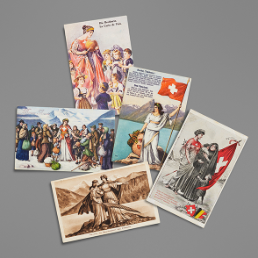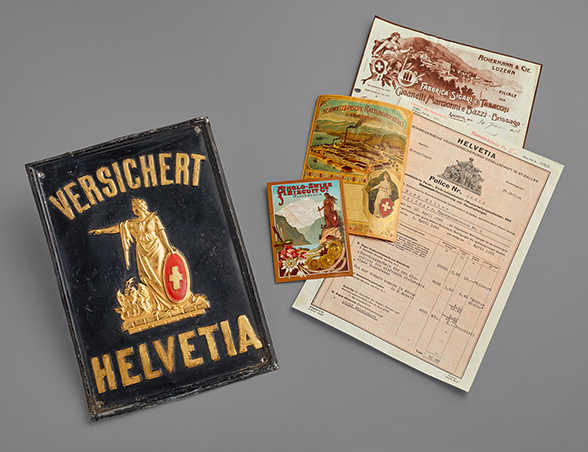Particularly in the early days of the Swiss federal state – which is celebrating its 175th anniversary in 2023 – the motif of Helvetia appeared on all types of visuals. Hans Rudolf Scheidegger's extensive collection shows the full spectrum of the various Helvetia motifs.
By Beat Scherrer
Private collector Hans Rudolf Scheidegger carefully compiled, collated and organised countless depictions of Helvetia in 24 albums. They give an insight into the myriad ways the figure of Helvetia has been used over the years: from postage stamps and writing paper, to names of companies, hotels and restaurants; and from building insurance signs, postcards and greetings cards to caricatures and billboards. She was even a figure of comfort and protection during the First World War.
Who or what exactly is Helvetia?
According to the Historical Dictionary of Switzerland (LHS) Helvetia is the female personification of Switzerland. In the LHS, Georg Kreis also writes that we can distinguish two different versions of Helvetia: one that is relatively neutral and represents Switzerland as a geographic area, and one that represents the birth of the Swiss nation.
The image on the title page of Matthäus Merian's “Topographia Helvetiae” of 1642 is considered the first iconographic depiction of Helvetia. She bears symbols of agriculture, which primarily represent abundance, and should therefore be interpreted as purely geographical. Initially, she had to share her role with male figures, but in the 18th century, the female figures became increasingly prevalent – with Helvetia featuring alongside other female figures from Antiquity.
As Swiss national identity grew in the 19th century, and in connection with the founding of the Swiss federal state in 1848, Helvetia increasingly became politicised. She started to feature weapons (spear or sword) and a shield. The newly inaugurated federal state took on new sovereign tasks that were previously the responsibility of the individual cantons and now had to be standardised. Above all, however, the State had to establish itself in the minds of the people, who had previously identified with their respective cantons. There was also a desire to promote the idea of Switzerland as a nation. This is how Helvetia came to be the face of the new Switzerland so to speak. The first coin embossed with her image was issued in 1850 and she first appeared on a postage stamp in 1854. The official Latin name for the Swiss Confederation – Confœderatio helvetica (CH) – was also testament to her rising profile in the national consciousness.
Helvetia everywhere

In the second half of the 19th century, representations of Helvetia experienced a veritable boom. For example, whole series of postcards were released with pictures of various Swiss towns “guarded over” by Mother Helvetia. She also continued to appear frequently as a patron for anniversaries, or simply as a figure on letterheads and logos, often without being explicitly named. Clubs and institutions also used her name, as did companies other than hotels and restaurants, such as Helvetia sewing machines, Helvetia cigars, and Helvetia fire insurance. There were also (steam) boats named Helvetia, and a union, music societies and choirs with Helvetia in their names.
From the First World War to today

During the First World War, Helvetia often represented Switzerland's good offices and served as a source of comfort and hope in hard times. This is shown by the many postcards that were printed and distributed to “bolster the morale” of the public and the armed forces. Helvetia is portrayed as a soldier's mother, as a mother of starving children, as a carer of refugees and internees, as a nurse and as a bearer of good wishes for the new year or Swiss National Day on 1 August.
After the First World War, the Helvetia motifs gradually disappeared. Today, Helvetia's image still features on the 50 cent and 1 and 2 Swiss franc coins (incidentally with an image that is unchanged since 1874), and the word “Helvetia” still features on postage stamps. Otherwise, the image of Helvetia appears rarely in modern imagery. That said, she is to feature once again on a special postage stamp to mark the anniversary of the Swiss federal state in 2023.
Hans Rudolf Scheidegger (1939–2020), from the Bernese Seeland region, trained as a telecommunications engineer and subsequently worked as a service technician at various firms. He started collecting in the 1970s, and besides the collection of Helvetia representations shown here, also held a collection of radios (now in the ENTER Museum in Solothurn) and a large stamp collection.
Bibliography and sources
- Gianni Haver: Dame à l’antique avec lance et bouclier: Helvetia et ses déclinaisons, in: Gonseth et al. (Ed.): Hors-champs. Eclats du patrimoine culturel immatériel, Ethnographic Museum of Neuchâtel, 2013, p. 274–282.
- Georg Kreis: Helvetia (Allegorie), in: Historical Dictionary of Switzerland, version dated 13.10.2014. Online (consulted on: 6.1.2023)
- Georg Kreis: Helvetia – im Wandel der Zeiten. Zürich: Verlag Neue Zürcher Zeitung, 1991
- Marie-Louise Schaller: Helvetia antiqua et nova. Antike Vorbilder für eine Integrationsfigur der Schweiz, in: Helvetia archaeologica: Archäologie in der Schweiz, Nr. 101/102, 1995, S. 2-62
- Angela Stercken, Enthüllung der Helvetia. Berlin: D. Reimer, 1998
- Hans Rudolf Scheidegger's collection in the HelveticArchives database
- Digital copy of “Matthäus Merian: Topographia Helvetiae”, 1642
- Original edition in the NL of “Matthäus Merian: Topographia Helvetiae”, 1642
-
«14-18. La Suisse en cartes postales» In the section “Allegories of Switzerland” this website presents in detail a number of postcards with the Helvetia motif from the First World War period (in French).
- Helvetia on a contemporary political poster (popular initiative for the abolition of flat-rate taxation)
- Helvetia in contemporary advertising (advert for Skoda cars)
Last modification 07.02.2023
Contact
Swiss National Library
Prints and Drawings Department
Hallwylstrasse 15
3003
Bern
Switzerland
Phone
+41 58 462 89 71









